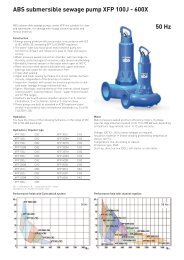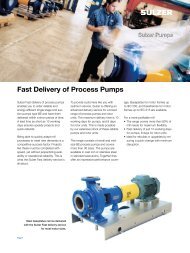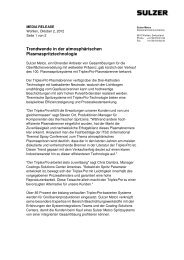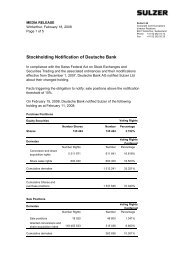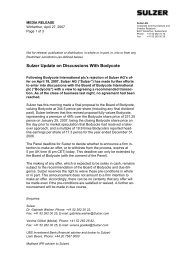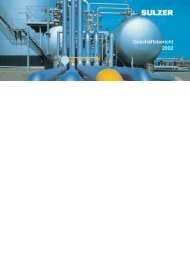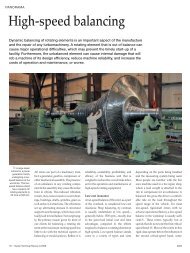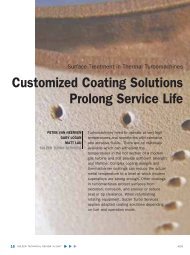Testing and quality
Testing and quality
Testing and quality
Create successful ePaper yourself
Turn your PDF publications into a flip-book with our unique Google optimized e-Paper software.
A product development process at<br />
Sulzer Mixpac also has to pass through<br />
a number of stages—from the product<br />
idea through the first prototypes to the<br />
manufacturing of the tools 1 <strong>and</strong> the<br />
subsequent production by injection<br />
molding <strong>and</strong> other manufacturing<br />
processes 2. The last milestone in the<br />
product development before the first<br />
“marathon“ is the so-called series<br />
approval. This example should illustrate<br />
that the process planning (the training<br />
plan), the determination of the process<br />
steps (the training), <strong>and</strong> also the mea -<br />
surement (target/actual) are decisive for<br />
the success of the product development<br />
3. Processes <strong>and</strong> their desired results<br />
have to be defined before they can be<br />
measured. At Sulzer Mixpac, it is taken<br />
for granted that “if something needs to<br />
be improved, one first has to measure it.”<br />
Sulzer Mixpac is a “top athlete” in the<br />
plastics industry. The company does not<br />
deal with all types of plastics, however.<br />
The focus lies on the world of semi-crystalline<br />
thermoplastics. Due to their properties,<br />
semi-crystalline thermoplastics<br />
are being increasingly used. At the same<br />
time, however, the specifications <strong>and</strong><br />
legal regulations for the industries are<br />
becoming stricter. Both the legal requirements<br />
<strong>and</strong> the daily pursuit of optimal<br />
processes require solid measurement<br />
<strong>and</strong> analysis technology based on stateof-the-art<br />
science <strong>and</strong> technology. These<br />
technologies are used in research <strong>and</strong><br />
development, <strong>quality</strong> testing, <strong>and</strong> process<br />
<strong>and</strong> product optimizations, as well as<br />
for failure analysis.<br />
A wide b<strong>and</strong>width of physical <strong>and</strong><br />
analytical methods is necessary in order<br />
to portray the complete product development<br />
process in a measurable manner.<br />
In its own laboratories, Sulzer Mixpac<br />
has the required instrumentation, the<br />
many years of experience, <strong>and</strong> the knowhow<br />
that are necessary for the polymer<br />
analysis.<br />
Thermal analysis<br />
Many of the properties of the starting<br />
materials that are important for plastic<br />
injection molding, <strong>and</strong> also for the end<br />
products, can be determined with the<br />
help of thermal analysis.<br />
• DSC (differential scanning calori -<br />
metry): DSC analysis measures the<br />
necessary amounts of heat that are<br />
used or arise in the physical transformation<br />
of the plastic. The reaction heat,<br />
the decomposition temperatures, <strong>and</strong><br />
also the glass transition <strong>and</strong> melting<br />
ranges can be cited as examples.<br />
• TGA (thermo-gravimetric analysis):<br />
The composition <strong>and</strong> filling materials<br />
of the returns can be analyzed through<br />
the “controlled evaporation” of plastics.<br />
In order to do this, the materials<br />
are heated up to 1100 °C.<br />
Rheology<br />
Rheology describes the flow characteristics<br />
of substances. In the plastics<br />
industry, this property is a very<br />
important measurement parameter for<br />
the processing of various plastics, as<br />
well as for the individual batches of<br />
the same plastics.<br />
• MFR/MVR (melt flow rate/melt<br />
volume rate): The end result provided<br />
by the melt flow rate (MFR) is the<br />
flow behavior of the plastic under<br />
certain temperature <strong>and</strong> pressure conditions.<br />
The viscosity of the plastic<br />
melt is determined by this measurement<br />
procedure.<br />
2 Injection molding production in Haag, Switzerl<strong>and</strong>.<br />
• Rotation viscometer: Lying on a<br />
heated plate, a plate or a cone is<br />
pressed on to the specimen by means<br />
of a pressure-driven motor. During the<br />
rotation process, the frictional force<br />
(torque) that is necessary to overcome<br />
the flow resistance is measured. The<br />
result measured is, for example, the<br />
shear viscosity of the specimen. This<br />
measurement is taken to determine<br />
the characteristics of plastics or mixed<br />
adhesives with regard to workability<br />
<strong>and</strong>/or mixing <strong>quality</strong>.<br />
Spectroscopy<br />
It is possible to determine the structure<br />
<strong>and</strong>/or the identity of the plastic<br />
through spectroscopy. With color analysis,<br />
it is, thereby, possible to break down subjective<br />
color perceptions into reproducible<br />
measurements.<br />
• FTIR (Fourier transformation infrared<br />
spectrometer): With this measuring<br />
instrument, it is possible to carry out<br />
very fast identifications (characterizations)<br />
on organic materials. The<br />
specimen is clamped in the ATR unit<br />
<strong>and</strong> is, thereby, placed in the path of<br />
a laser-controlled infrared beam. The<br />
penetration of the radiation excites the<br />
atomic groupings of the melt (vibrations),<br />
from which the absorption<br />
spectrum can be measured. The position<br />
<strong>and</strong> intensity of these peaks<br />
are characteristic for certain atomic<br />
groupings. By comparison with the<br />
“st<strong>and</strong>ard spectra” available in the<br />
database, the material characterization<br />
<strong>and</strong> contamination of plastics, as<br />
examples, can be carried out quickly<br />
<strong>and</strong> easily.<br />
TESTING AND QUALITY<br />
Sulzer Technical Review 1/2011 |<br />
19



